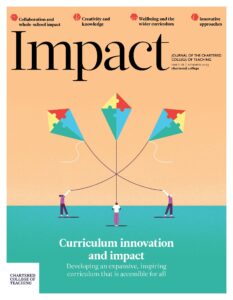Teaching for creativity using the five creative habits of mind at primary and secondary

RUTH BROWN, FACULTY LEAD CREATIVE ARTS, DUCHESS’S COMMUNITY HIGH SCHOOL, UK
RYAN LONGSTAFF, DEPUTY HEADTEACHER, CAMBOIS PRIMARY SCHOOL, UK
NIA RICHARDS, PROGRAMME MANAGER, CREATIVITY, CULTURE AND EDUCATION (PARTNER TO THE NORTH EAST CREATIVITY COLLABORATIVE), UK
The North East Creativity Collaborative is one of eight cohorts in Art Council England’s three-year programme, testing practices in teaching for creativity. The initiative responds to the Durham Commission’s Creativity and Education report (Durham University, 2019), which suggested that knowledge and creativity shouldn’t be in conflict within our education system; rather, they are both equally imperative and, indeed, are synergetic. Creativity is a vital real-world capability but it’s also a bridge that supports learner curiosity, engagement and ability to leverage ownership over their learning.
Our research as a collaborative of eight schools began by agreeing a common understanding and definition of creativity, which led to us challenging our assumptions along the way, particularly around the ‘creative’ teacher. We realised that we had to move away from stereotypical thinking – we didn’t need to be artists or musicians to be able to teach for creativity. Through the five creative habits of mind model (Lucas et al., 2013), we were able to reflect on our practice and recognise our existing strengths across all subjects and age phases. The model has given us clarity and equipped us with a vocabulary around the dispositions of thinking creatively – being imaginative, inquisitive, persistent, collaborative and disciplined – that allows us to build on existing good practice and explore new approaches.
As a collaborative, we have invested as much time in building and powering our professional learning community (PLC) as we have in exploring creativity. The PLC offers us the opportunity to reflect, think, plan, discuss, share and debate the complexities of teaching for creativity. The fact that we all come from different types of schools and contexts adds a different and exciting dimension to our learning, where we work together with a sense of agency and shared purpose.
Each school is directing their own spirals of enquiry (Timperley et al., 2014), modelling their own creative habits of mind in continuous cycles, from the sub-habits of wondering and questioning, to tolerating uncertainty, to reflecting critically and back again. At Cambois Primary School, we have spent time reflecting on our curriculum and, with the support of a creative practitioner, we have worked with our staff to examine where we might be able to develop creativity further. We are currently trialling a ‘split-screen’ teaching approach, whereby subject knowledge is matched to a complementary creative habit of mind, prompting us to be explicit about creativity rather than leaving it to chance. For example, we have paired the habit of ‘disciplined’ and the sub-habit of ‘crafting and improving’ with literacy, and simultaneously we are supporting our learners to value creativity; they now recognise that being persistent or disciplined is equally important to gaining academic knowledge. They understand that learning is often difficult and grasping concepts can take time, but the creative habits of mind are the stepping stones, or the thinking, within the process.
Duchess’s Community High School is the lead school for the collaborative due to previous experience of teaching for creativity. Since introducing the creative habits of mind model to the faculty at Key Stage 3 in 2019, we saw a one-third increase in students’ termly performance compared to the previous year. Teachers report that students who started their ‘habits’ journey in Year 7 are now more resilient, adaptable learners in Year 10 when compared to their contemporaries in Year 11 at the same stage. Our Key Stage 3 ‘CREATE’ curriculum model embraces the language of the creative habits, and children are coached by teachers to use the habits as integral to their learning. Persistence is a trait that challenges most children – the fear of getting something wrong and seeing their ideas through. Using the habits, failure becomes part of the dialogue, being able to recognise the successes and areas upon which to build. Children are encouraged to reflect upon this as a journey – to seek out new routes forward rather than accepting the first answer or, worse, simply modelling the teacher’s answer for fear of not wanting to test their own knowledge.
Since the Creative Arts Faculty began focusing on teaching for creativity, one of the most interesting aspects has been the growth in confidence in the approach and use of this model from students and staff. We plan more effectively using this model, due to our collaborative approach across four subject disciplines. Assessments have been developed with the creative habits as a learning objective, alongside a knowledge- and skills-rich curriculum. As we have progressed along our own professional learning pathway, we have engaged in rich conversations around core subject priorities, where there might be multidisciplinary links and mutually expansive opportunities both within and outside the school setting.
Although teaching for creativity might start with the curriculum, it also needs to be combined with pedagogical planning. Teaching is a highly skilled and creative profession, something that we tend to neglect as educators when faced with the constraints of examination cycles and external pressures. Therefore, some of our settings in the collaborative have started to study approaches in SEND (special educational needs and disabilities), Beach and Forest schools to identify the pedagogical principles of teaching for creativity and the learning environments and cultures that promote it – a much more ambiguous task, which requires us to unravel the paradigm or mindset shift towards creativity.
We have more to do, particularly around assessing and tracking progress in creativity, but we now know that creativity has to have a shared understanding and vocabulary, it has to be visible and audible around the school, and it can be integrated into all areas of the curriculum. We know that leadership support and time for reflective practice with colleagues is essential to teach for creativity, but it also starts with us nurturing our own creativity and incorporating the habits into our professional identities.
- Durham University (2019) Durham Commission on Creativity and Education. Available at: www.dur.ac.uk/resources/creativitycommission/DurhamReport.pdf (accessed 8 May 2023).
- Lucas B, Claxton G and Spencer E (2013) Progression in student creativity in school: First steps towards new forms of formative assessments. OECD Education Working Papers, No. 86. OECD Publishing. DOI: 10.1787/5k4dp59msdwk-en.
- Timperley H, Kaser L and Halbert J (2014) A framework for transforming learning in schools: Innovation and the spiral of inquiry. Centre for Strategic Education, Seminar Series Paper No. 234. Available at: www.educationalleaders.govt.nz/Pedagogy-and-assessment/Evidence-based-leadership/The-spiral-of-inquiry (accessed 23 March 2023).










